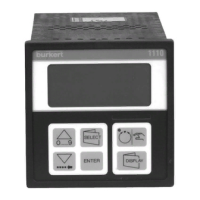1110 - 79
DIGITAL INDUSTRIAL CONTROLLER
english
Step 1:
Either use the tune function to determine starting parameters or select
the starting parameters in the parameter definition level,
Controller
option:
• Set the
proportional action coefficient / Gain Kp
to a value that will
produce a lasting system deviation of < 80% of the given setpoint
change in the stationary process state.
• Set the
reset time Tr
to a very high value (e.g. 9999 s).
• Leave the
derivative action time Td
at 0 (works setting) if you are
trying to optimise a PI structure or set the derivative action time Td
to 0.1 if you wish to optimise a PI structure.
Step 2:
Select options in the parameter definition level,
Adaption
option:
• Activate
adaption
• Select
Setpoint in several stages
Step 3:
Enter the required process setpoint in the process control level.
Under these conditions, the process setpoint is set in up to 5 stages
and, in doing so, the controller parameters are optimised in each
stage.
Configuration and parameter definition levels
Both in the configuration and also in the parameterisation levels, first the
Tune
module and then the
Adaption
module can be used for adaption in the sub-menus.
However, Tune and Adaption cannot be run simultaneously (cf. Par. 7.4).
When the
Tune: on
option is selected, the controller parameters are optimised the
first Time the setpoint changes. When using a corresponding output as detailed in
the table at paragraph 7.5, the
Adapt: on
option produces an evaluation of the
controlled variable’s transient response with each change in the setpoint and, if
applicable, optimisation of the controller parameters.
The
SP
↑↑
: yes
option activates a new setpoint is set in several stages within the
adaption function, each of these stages being used for one optimisation cycle.
If
SP
↑↑
:no
is selected, optimisation takes place in one stage.
When the
PV
↑
: yes
or
PV
↑
: no
option is selected, the adaption function performs
optimisation on the basis of the shortest control stabilisation time with 5 %
overshoot or an aperiodic transition response.
Process operating level
The adaption process cannot be influenced directly in the
process operation
level. A
running adaption cycle can, however, be aborted by pressing the MANUAL/
AUTOMATIC key twice.
If the setpoint is changed while an adaption cycle is running, adaption is aborted
and a new adaption cycle is initialised on the basis of the new setpoint according to
the options selected during configuration or parameter definition.
7.6 Operating the tuning and adaption functions

